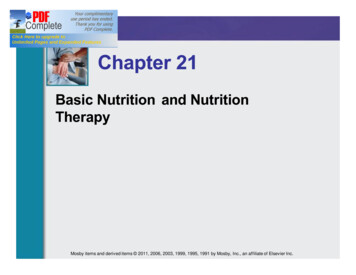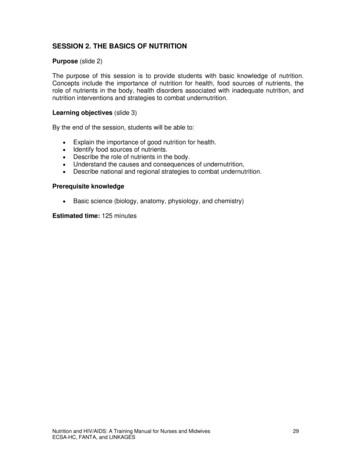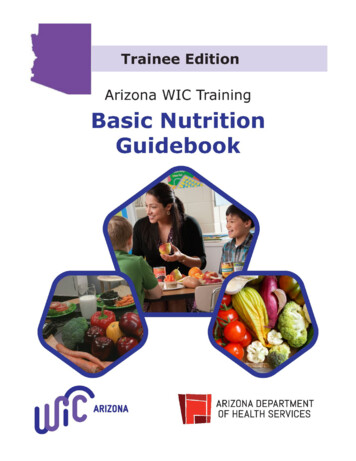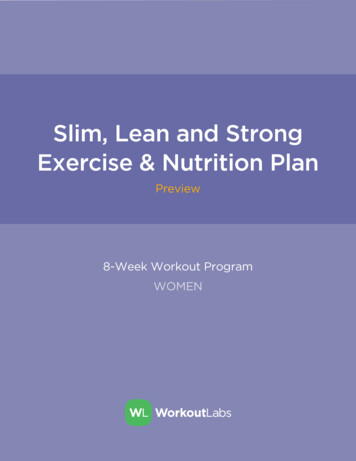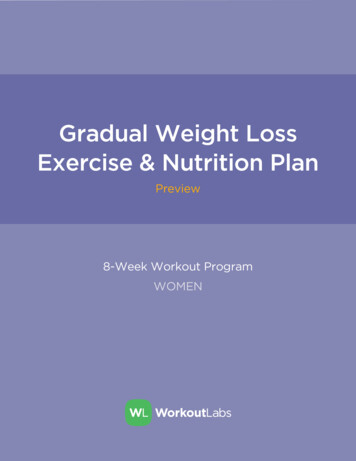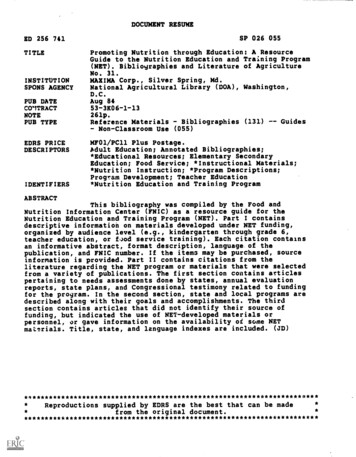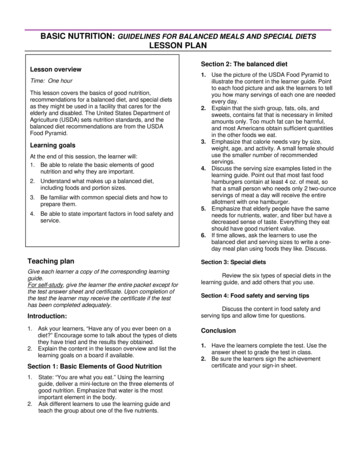
Transcription
BASIC NUTRITION: GUIDELINES FOR BALANCED MEALS AND SPECIAL DIETSLESSON PLANLesson overviewTime: One hourThis lesson covers the basics of good nutrition,recommendations for a balanced diet, and special dietsas they might be used in a facility that cares for theelderly and disabled. The United States Department ofAgriculture (USDA) sets nutrition standards, and thebalanced diet recommendations are from the USDAFood Pyramid.Learning goalsAt the end of this session, the learner will:1. Be able to relate the basic elements of goodnutrition and why they are important.2. Understand what makes up a balanced diet,including foods and portion sizes.3. Be familiar with common special diets and how toprepare them.4. Be able to state important factors in food safety andservice.Teaching planGive each learner a copy of the corresponding learningguide.For self-study, give the learner the entire packet except forthe test answer sheet and certificate. Upon completion ofthe test the learner may receive the certificate if the testhas been completed adequately.Introduction:1. Ask your learners, “Have any of you ever been on adiet?” Encourage some to talk about the types of dietsthey have tried and the results they obtained.2. Explain the content in the lesson overview and list thelearning goals on a board if available.Section 1: Basic Elements of Good Nutrition1.2.State: “You are what you eat.” Using the learningguide, deliver a mini-lecture on the three elements ofgood nutrition. Emphasize that water is the mostimportant element in the body.Ask different learners to use the learning guide andteach the group about one of the five nutrients.Section 2: The balanced diet1. Use the picture of the USDA Food Pyramid toillustrate the content in the learner guide. Pointto each food picture and ask the learners to tellyou how many servings of each one are neededevery day.2. Explain that the sixth group, fats, oils, andsweets, contains fat that is necessary in limitedamounts only. Too much fat can be harmful,and most Americans obtain sufficient quantitiesin the other foods we eat.3. Emphasize that calorie needs vary by size,weight, age, and activity. A small female shoulduse the smaller number of recommendedservings.4. Discuss the serving size examples listed in thelearning guide. Point out that most fast foodhamburgers contain at least 4 oz. of meat, sothat a small person who needs only 2 two-ounceservings of meat a day will receive the entireallotment with one hamburger.5. Emphasize that elderly people have the sameneeds for nutrients, water, and fiber but have adecreased sense of taste. Everything they eatshould have good nutrient value.6. If time allows, ask the learners to use thebalanced diet and serving sizes to write a oneday meal plan using foods they like. Discuss.Section 3: Special dietsReview the six types of special diets in thelearning guide, and add others that you use.Section 4: Food safety and serving tipsDiscuss the content in food safety andserving tips and allow time for questions.Conclusion1. Have the learners complete the test. Use theanswer sheet to grade the test in class.2. Be sure the learners sign the achievementcertificate and your sign-in sheet.
BASIC NUTRITION: GUIDELINES FOR BALANCED MEALS AND SPECIAL DIETSLEARNING GUIDEBASIC ELEMENTS OF GOOD NUTRITIONEverybody needs these in the rightamounts.NUTRIENTSElements of food used by the body for energy,maintenance, healing, and growth1. Proteins: for growth of muscle and bodytissueSources: meat, fish, eggs, milk, peas,beans, nuts2. Carbohydrates: for energySources: bread, grains, cereals,potatoes, peas, beans3. Fats: for warmth, vitamin storage, andenergySources: meat, dairy products,vegetable oils, egg yolks4. Vitamins: for healthy functioning of bodysystemsSources: fruit, vegetables, meat, dairyproducts5. Minerals: for growth, strength, andhealthy blood, bones, and body systemfunctionsSources: fruit, vegetables, meat, fish,dairy products, grainsFIBERImportant for digestion and waste elimination.Sources: cereals, grains, fruits, vegetablesFLUIDSBody weight 2/3 waterDaily need 80 oz. fluid intake (8–10 glasses)Fluid intake should equal fluid outputToo much water loss DehydrationNot enough water loss EdemaUrine 40% of fluid outputEvaporation 60% of fluid outputTHE BALANCED DIETWe all need balanced intake from five groups:1. Breads, cereals, rice, pasta(6–11 servings)2. Vegetables (3–5 servings)3. Fruits (2–4 servings)4. Meat, poultry, fish, beans, eggs, nuts (2–3 servings)5. Milk, yogurt, cheese (2–3 servings)AND6. Limited intake of fats, oils, and sweetsUsing a variety of different foods withinthese groups ensures balance and goodnutrition.What’s a Serving?1 serving of breads, cereals, rice, pasta 1 slice bread or 1 tortilla½ cup cooked rice or pasta1 oz. cereal1 serving of vegetables 1 cup leafy vegetables (salad)10 french fries½ cup cooked vegetables1 serving of fruit ½ cup canned fruit1 apple, orange, or banana¾ cup fruit juice1 serving of meat, poultry, fish, beans, eggs 2–3 oz. meat, poultry, fish½ cup dry beans or peas2 tablespoons peanut butter1 egg1 serving of milk, yogurt, cheese 1 cup milk8 oz. yogurt1.5 oz. cheddar cheeseFood fact: Calories are the amount of energy in food. Calorie need varies by size, weight, age, andactivity.Body metabolism slows as we age, so the elderly require fewer calories. However, the need for water,fiber, and all nutrients remains the same in older people—so eating healthy food is more important!
Special dietsMany people have special dietaryneeds because of illness, surgery,or ongoing conditions. Be sure thatyou know the type of diet everyresident in your facility is supposedto be eating. Mistakes on specialdiets can have serious results andcause many problems for theresident.Low saltAlso called restricted sodium or lowNA (the chemical abbreviation forsalt or sodium). Many people withheart or kidney disease or highblood pressure must eat this way.Guidelines:1. Little or no salt is used inpreparing food.2. No salt should be added bythe resident.3. Salty snacks are notallowed (e.g., potato chips,pretzels).4. Condiments that containsalt may be prohibited(catsup, mustard,margarine).Low fat (also low cholesterol)Often recommended for peoplewith heart disease or obesity.Guidelines:1. Eat low fat foods likechicken, vegetables, fruits,pasta, and cereal.2. Do not eat fatty foods likeice cream, egg yolks,bacon, and sausage (or eatin very small amountsrarely).SoftThis diet helps people who havedifficulty chewing or suffer fromcertain kinds of stomach trouble.Guideline:1. Eat cooked vegetables,ground meat, fish, andpureed foods.Diabetic—follow the plan!It is important for people withdiabetes to eat the right foods,whether or not they are takinginsulin or other medicine to controltheir diabetes. A diabetic residentshould have a diet plan designedespecially for him or her by adoctor or nutritionist. It will specifycertain amounts of carbohydrates,proteins, and fats.High proteinA resident who has just hadsurgery or who has a wound oftenneeds high protein to speedhealing. To get protein, eat lots ofmeat, fish, eggs, beans,peas, and dairy productsLiquid diets1. Full liquid includes allliquids, such as strainedsoups, milk, and ice cream.2. Clear liquid includes onlyliquids you can see through,such as water, tea, applejuice, clear broth, and blackcoffee (no cream or milk).Food safetyTo avoid food poisoning: Never undercookmeat—cook untilmeat temperature is165 degrees to killthe bacteria Refrigerated foodsmust be kept below45 degrees Thaw frozen foodsquickly and cookthem before theyreach room temp. Foods that will spoilat room temperatureshould be preparedlast Keep fresh foodsseparate from eachother and usedifferent surfacesand utensils whenpreparing each one Cover unservedportions to preventcontamination Cool leftoversquickly, refrigerate insmall containersTaste tip: Elderly people have a decreased sense of taste, andoften their stomachs can’t handle spicy foods. Fresh, tasty foodswith creative seasoning will help them get the nutrients they need. Serving tipsIf a resident has impaired vision, identify the foods on hisplate by using the clock face: “Your pork chop is at 3o’clock, your mashed potatoes are at 6 o’clock, and yourpudding is in a separate dish above the plate at 12 o’clock.”When feeding a resident, identify the foods and ask theresident what food he wants next. Offer seasonings ifallowed. Offer liquids often, using a different straw for eachliquid. Allow hot liquids to cool. Offer one bite at a time,using a spoon two-thirds full.Serve hot foods hot and cold foods cold!
Basic Nutrition TestName/Title: Score:(24 correct answer s required out of 32)Write the Special Diet that Fits Each Dish on t he MenuSalmon Fillet with Bl ack BeansSalmon with poached eggs and black beansGrilled Chi cken PlateChicken with green salad and apple wedgesBeef-Vegetable CasseroleGround beef and cooked vegetables in a creamy casseroleCream SoupStrained potato soup, with ice cream for dessertPork Chops and RiceGrilled pork and rice; no sauces, salt, or condimentsDieter’s DelightChicken broth with apple juice and black coffeeHow much fluid should we take in each day?What temperature should meats be cooked to?What temperature should refrigerated foods be kept below?What are the three basic elements of good nutrition? (three points)List the five types of nutrients and one thing each one does. (ten points)List the five basic food groups and the number of servings needed daily for each. (ten points)
Basic Nutrition Test: Answer Sheet24 correct answers required out of 32Write the Special Diet that Fits Each Dish on t he MenuSalmon Fillet with Bl ack BeansSalmon with poached eggs and black beansGrilled Chi cken PlateChicken with green salad and apple wedgesHigh ProteinLow FatBeef-Vegetable CasseroleGround beef and cooked vegetables in a creamy casseroleCream SoupStrained potato soup, with ice cream for dessertPork Chops and RiceGrilled pork and rice; no sauces, salt, or condimentsDieter’s DelightChicken broth with apple juice and black coffeeSoftFull LiquidLow SaltClear LiquidHow much fluid should we take in each day? 80 ounces (8-10 glasses)What temperature should meats be cooked to? 165 degreesWhat temperature should refrigerated foods be kept below? 45 degreesWhat are the three basic elements of good nutrition?Nutrients, Fiber, FluidsList the five types of nutrients and one thing each one does.1. Proteins: muscle and body tissue growth. 2. Carbohydrates: energy. 3. Fats: warmth, vitamin storage,energy. 4. Vitamins: healthy system functions. 5. Minerals: strength, growth, healthy blood, bones, andbody system functions.List the five basic food groups and the number of servings needed daily for each:1. Breads, cereals, rice, pasta (6-11 servings) 2. Vegetables (3-5 servings) 3. Fruits (2-4 servings)4. Meat, Poultry, Fish, Beans, Eggs, Nuts (2-3 servings) 5. Milk, Yogurt, Cheese (2-3 servings)
Facility:Certificate of AchievementEmployee Name:Course: “Basic Nutrition: Guidelines for Balanced Meals and Special Diets”Course Length: 1 HourParticipant correctly answered at least 8 of the 12 test questions.S i g n a t u re o f P re s e n t e r ( o r w r i t e “ s e l f - s t u d y ” )D ate
BASIC NUTRITION: GUIDELINES FOR BALANCED MEALS AND SPECIAL DIETS LEARNING GUIDE BASIC ELEMENTS OF GOOD NUTRITION Everybody needs these in the right amounts. NUTRIENTS Elements of food used by the body for energy, maintenance, healing, and growth 1. Proteins: for growth of muscle and body tissue Sources: meat, fish, eggs, milk, peas, beans,




